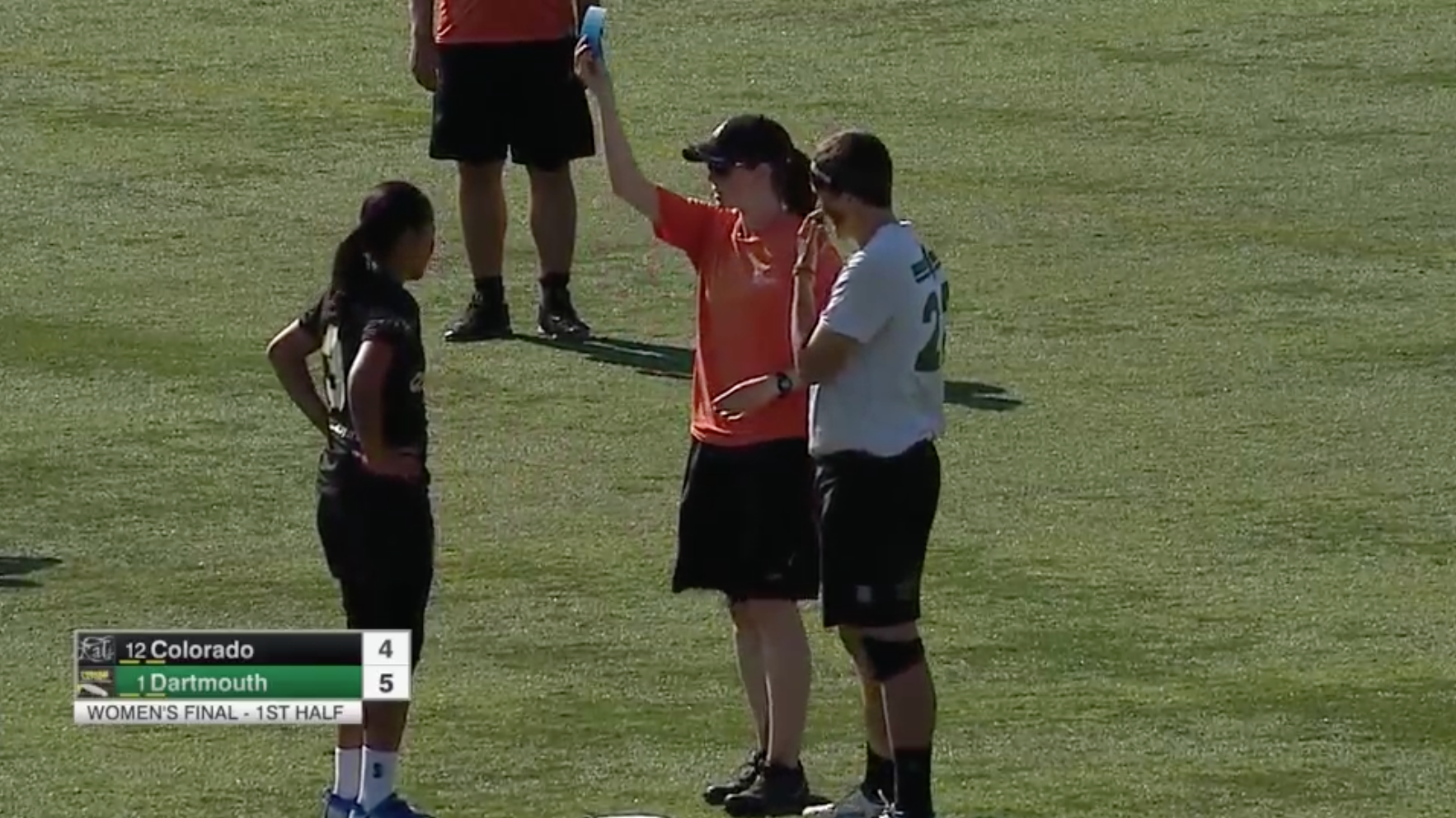Dangerous plays were discussed -- and penalized.
June 1, 2018 by Charlie Eisenhood in Analysis, News with 0 comments

Leading Colorado 5-4 in the Women’s College Championship final, Dartmouth was hunting the game’s first break.
Julianna Werffeli, Dartmouth’s Callahan nominee, threw an outside-in backhand to Jaclyn Verzuh, cutting underneath. The throw, though, was a bit too far to the inside shoulder of Verzuh, opening up a possible angle for her defender, Nhi Nguyen, to make a play. Nguyen dove for the disc. Verzuh, sensing pressure, had started to cut back in towards the disc. Both players converged on the disc simultaneously, but Nguyen collided with Verzuh.
Verzuh called a foul and Nguyen disagreed. They took the call to the observer, Laura Meyer, who ruled it a foul, then paused briefly. “In addition,” she said, holding up a blue card to signal a Team Misconduct Foul (TMF), “it was a dangerous play.”
***
“Dangerous play.”
It’s a phrase that’s been in the rules of ultimate for years, but its application in the game has been murky. It’s easy to identify some dangerous plays — an obviously egregious bid through somebody’s back, for instance — but agreeing on how much contact is allowable before ‘I got the disc first’ is no longer an excuse has been a challenge.
USA Ultimate seems to have come to the same conclusion. Before the College Championships, USAU sent out a document clarifying the rule and offering various scenarios in which it could be invoked.
“We felt like the players didn’t have a good understanding of when they could call dangerous play,” said National Observer Director Mitch Dengler, adding, “We wanted to make sure all the teams were on the same page coming into this tournament. And player safety has been an issue on the forefront for the last couple of years because a lot of players are getting hurt, and a lot of players are bringing it up.”
There has been plenty of discussion of the volume and degree of seemingly dangerous plays that have gone uncalled or, at least, uncarded in recent seasons. While observers have always had the ability to give out a TMF or a Personal Misconduct Foul (PMF) for such plays, they have been uncommon.
That seemed to change this weekend at the College Championships. Dengler said that there was a “point of emphasis” placed on player safety for the tournament and that observers, who are tasked with making rulings on calls and helping to set the norms around fair play, discussed the dangerous play rule and its usage before the tournament began.
There was an obvious difference. More borderline plays were getting TMFs. More blatantly bad bids were getting PMFs1.
“Players were definitely using the term ‘dangerous play’ more often, and I think that’s a direct result of the communication we made,” said Dengler. “And that certainly makes our job a lot easier.”
And that brings us back to the Nguyen bid on Verzuh. Nguyen wasn’t happy about the ruling, posting a photo of the bid on Twitter after the tournament:
No doubt it was borderline. Plenty of viewers argued it wasn’t even a foul, let alone a dangerous play. Others thought it warranted the call because Verzuh got to the space first.
Whether or not this play would have been ruled a foul in the past, it almost certainly wouldn’t have been issued a TMF by the observers. This weekend broke new ground in the policing of physicality in ultimate.
With the 12th edition rules currently in the drafting process, there may be changes coming to what constitutes a dangerous play. The World Flying Disc Federation’s rules, which govern almost all play outside of North America, are stricter on this topic: “Reckless disregard for the safety of fellow players is considered dangerous play and is to be treated as a foul, regardless of whether or when contact occurs. This rule is not superseded by any other rule.”
It’s crystal clear: contact is not required in order to call a dangerous play under WFDF rules. Bids that only could have been dangerous, given a different outcome, can be ruled fouls.
Perhaps USA Ultimate will align closer to WFDF in the 12th edition. Perhaps they will seek to simply clarify the existing rule further. But what is certain is that USAU is working now to get dangerous plays out of a grey area and into a blue and yellow one.
Below is the dangerous play document that USA Ultimate sent out to teams before the College Championships.
PMFs serve as a serious warning. Getting a second PMF in a game is an automatic ejection, as with yellow cards in soccer. Getting a third during a single tournament is an automatic suspension for the remainder of the tournament. ↩